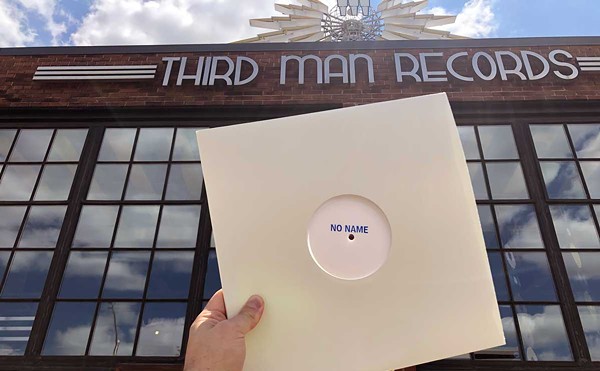Kenny Garrett’s torso sways back and forth when he solos on the alto sax, giving the impression that he’s building momentum to blast off. “I don’t know where the rocking came from,” Garrett says. “It just kind of developed. It’s a strange thing, you know. I’ve seen videotapes of Jewish people praying, and they kind of rock that way. I think that I started doing it once I got comfortable with myself. Sometimes I watch myself on videotape and I get dizzy.”
No less dizzying is Garrett’s storybook career, crammed with unforgettable solos. There’s the one he did on the Miles Davis album Live Around the World; Garrett blew as if his horn was rigged with hydraulics on the Michael Jackson tune “Human Nature.” Upon finishing, Davis informed the audience that Garrett played like that every night.
That was 17 years ago, and the 44-year-old multi-Grammy Award nominee is still rocking. The native Detroiter, who, by the way, can speak fluent Japanese, has a fat résumé too. He’s played with Sting, the rapper Guru, Springsteen, Peter Gabriel, Herbie Hancock and the Duke Ellington Orchestra, among others, and has a dozen solo albums to his credit.
For an alto player, Garrett has a heavy, deep, rich tone, one he developed by listening to tenor players, such as his stepfather Benny Grant and the late Joe Henderson.
Garrett, who would attend his stepfather’s gigs, says his dad “used to play the tenor and I would hear that sound. That tenor sound was always around. I just had to get it out the way that I was hearing it in my head. A lot of times I think musicians have this sound in their heads that they are trying to get. Some keep working until they get it.”
Stepdad Grant got Garrett interested in music and gave him his first sax. The horn was peculiar in that it sported a single bullet hole.
“I don’t know where the bullet hole came from, or where he purchased the horn. I was just happy to get it,” Garrett says.
Garrett worked his horn daily, some days seven hours. His high school music teacher introduced Garrett to Detroit trumpeter Marcus Belgrave. Belgrave was running the Jazz Development Workshop at a popular jazz joint called Cobb’s Corner. Back in the ’70s and ’80s, up-and-coming jazz musicians such as pianist Geri Allen, violinist Regina Carter, and bassists Bob Hurst and Greg Cook participated in the workshop. Kid Garrett joined, and at 15 he became the youngest member.
“Kenny had a sound in his playing that made people want to dance,” Belgrave says. “That gift is not something that you learn. Everything that I taught him he took to heart. He was just so attentive. I couldn’t stop talking to him.”
Organist Lyman Woodard had a jazz-funk band called the Lyman Woodard Organization that was the house band at Cobb’s. Woodard let Garrett sit in, and the young horn player stole the show. So, Woodard gave Garrett a gig.
“Kenny fit in very well,” Woodard says. “What I liked about him was he reminded me of my favorite alto player, Larry Smith. Larry played with me off and on. I just related to the way Kenny played right off the bat. He blended right in to what I was doing.”
All the while Garrett strove to get better. Woodard remembers telling Garrett that he was a talented young alto player but he hadn’t yet reached the level of Larry Smith. A few months later Garrett played Woodard a cassette tape and asked the bandleader to name the soloist. Woodard immediately said it was Larry Smith. He was wrong; it was Garrett soloing on the recording. Garrett’s gig with Woodard lasted two more years.
After graduating from high school, life was peachy for the young sax blower. At that point, Garrett, who was in three bands — the Jazz Development Workshop, Lyman Woodard Organization, and the II V I Orchestra — was a sought-after player. Then he landed his debut high-profile touring gig.
Normally, 17-year-olds are confused and uncomfortable with peer pressure and life’s choices. Garrett had to decide between attending Boston’s prestigious Berklee College of Music or hitting the road with the Duke Ellington Orchestra. His mother, like most, wanted her boy in school. Garrett chose the orchestra.
Here’s how the gig happened: In 1977, the Duke Ellington Orchestra had booked a few dates in Detroit, with Duke’s son Mercer as leader. Turns out their alto player had disappeared and they needed a replacement. Belgrave recommended Garrett. Mercer dug Garrett’s playing, and offered him a permanent gig. Garrett toured with the DE Orchestra for three and a half years.
Then he left Detroit for the Big Apple.
“At that point I felt that I had gotten as much as I could from Detroit,” Garrett says. “I had played with the cream of the crop here, and I got a good musical education. I wanted to be in New York to hear some different guys.”
In New York, Garrett roomed with renowned pianist Mulgrew Miller and performed mostly with big bands. He played with drummer Mel Lewis, trumpeter Thad Jones and multi-instrumentalist great Lionel Hampton before joining Art Blakey’s Jazz Messengers.
As a Jazz Messenger — a gig that lasted two years — Garrett learned, among other things, how to pace his soloing. Then a guy named Miles phoned.
Garrett got a heads-up from saxophonist Gary Thomas that Miles Davis was searching for an alto player. “Gary asked if I was interested. I said, ‘Of course, it’s Miles Davis.’ I called Miles and got his valet. Miles called me back. At first I didn’t believe it was him. I thought it was Mulgrew Miller. Mulgrew had been pretending to talk like Miles for years. When I finally realized it was Miles, we talked.”
Garrett sent Davis a performance he did with Blakey.
“Miles called me back and said that I sound like I was wearing Sonny Stitt’s dirty drawers.”
Translation: Garrett did justice to the memory of the late, great Stitt. Miles gave Garrett a dry run, which Garrett took with Blakey’s blessings. (Years later Davis confided in Garrett that he really wanted him all along after watching video footage of him playing with trumpeter Dizzy Gillespie and Blakey at the Berlin Jazz Festival.)
The five years he toured with Davis, Garrett’s reputation grew. After Davis died, Garrett began leading his own bands, and recording more as a leader.
“I always wanted to have my own band and play my own music. Miles gave me a platform for people to recognize me.”
In ensuing years, the Warner Brothers recording artist has continued to build on his pedigree, and it’s no wonder he’s considered one of the era’s finest jazz musicians. Each of his albums has its own melodic personality: African Exchange Student (1990) and Pursuance: The Music of John Coltrane (1996) are downright classics. But Simply Said (1999) was a bold work that upset some jazz purists with its stylistic twists and turns.
“I have always been the kind of person that loves music,” Garrett says. “I’ve played in big bands. I’ve played in R&B bands, and I’ve played hip hop. I love to challenge myself to play different styles of music. All the records that I have done I’ve done what I wanted to do. I have to say that’s a blessing.”
Performs Thursday, Feb. 17, at the Orchestra Hall in the Max M. Fisher Music Center (3711 Woodward Ave., Detroit; 313-576-5111) with the Professors of Jazz at MSU. Charles L. Latimer writes about jazz for Metro Times. Send comments to [email protected]





